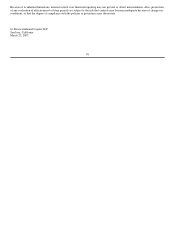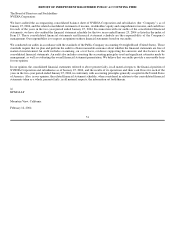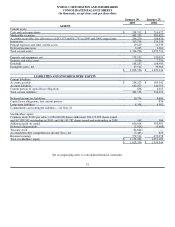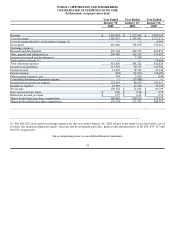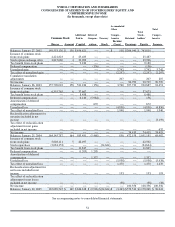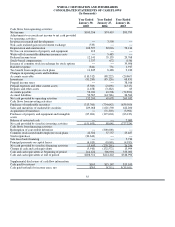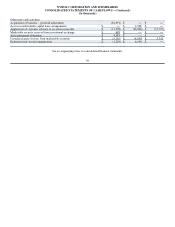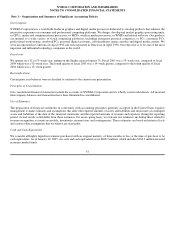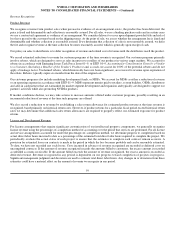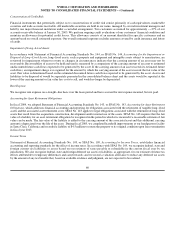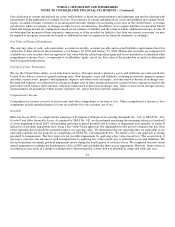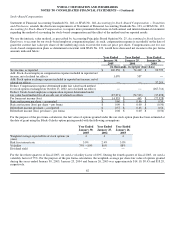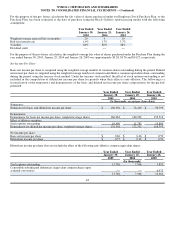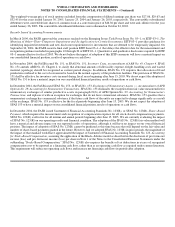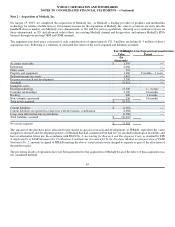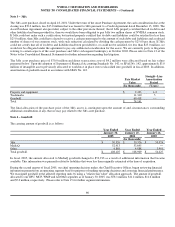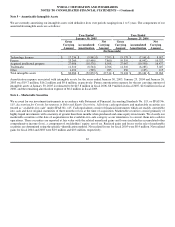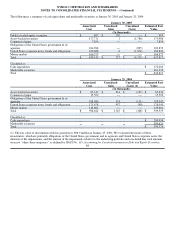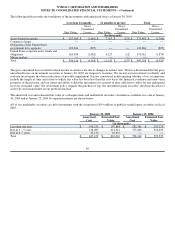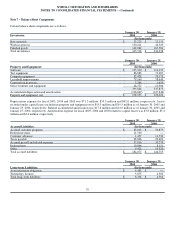NVIDIA 2005 Annual Report Download - page 66
Download and view the complete annual report
Please find page 66 of the 2005 NVIDIA annual report below. You can navigate through the pages in the report by either clicking on the pages listed below, or by using the keyword search tool below to find specific information within the annual report.
NVIDIA CORPORATION AND SUBSIDIARIES
NOTES TO CONSOLIDATED FINANCIAL STATEMENTS − (Continued)
Concentration of Credit Risk
Financial instruments that potentially subject us to concentrations of credit risk consist primarily of cash equivalents, marketable
securities and trade accounts receivable. All marketable securities are held in our name, managed by several investment managers and
held by one major financial institution under a custodial arrangement. Two customers accounted for approximately −−27% of our
accounts receivable balance at January 30, 2005. We perform ongoing credit evaluations of our customers' financial condition and
maintain an allowance for potential credit losses. This allowance consists of an amount identified for specific customers and an
amount based on overall estimated exposure. Our overall estimated exposure excludes amounts covered by credit insurance and letters
of credit.
Impairment of Long−Lived Assets
In accordance with Statement of Financial Accounting Standards No. 144, or SFAS No. 144, Accounting for the Impairment or
Disposal of Long−Lived Assets, long−lived assets, such as property and equipment and intangible assets subject to amortization, are
reviewed for impairment whenever events or changes in circumstances indicate that the carrying amount of an asset may not be
recoverable. Recoverability of assets to be held and used is measured by a comparison of the carrying amount of an asset to estimated
undiscounted future cash flows expected to be generated by the asset. If the carrying amount of an asset exceeds its estimated future
cash flows, an impairment charge is recognized for the amount by which the carrying amount of the asset exceeds the fair value of the
asset. Fair value is determined based on the estimated discounted future cash flows expected to be generated by the asset. Assets and
liabilities to be disposed of would be separately presented in the consolidated balance sheet and the assets would be reported at the
lower of the carrying amount or fair value less costs to sell, and would no longer be depreciated.
Rent Expense
We recognize rent expense on a straight−line basis over the lease period and have accrued for rent expense incurred, but not paid.
Accounting for Asset Retirement Obligations
In fiscal 2004, we adopted Statement of Financial Accounting Standards No. 143, or SFAS No. 143, Accounting for Asset Retirement
Obligations, which addresses financial accounting and reporting for obligations associated with the retirement of tangible long−lived
assets and the associated asset retirement costs. SFAS No. 143 applies to legal obligations associated with the retirement of long−lived
assets that result from the acquisition, construction, development and/or normal use of the assets. SFAS No. 143 requires that the fair
value of a liability for an asset retirement obligation be recognized in the period in which it is incurred if a reasonable estimate of fair
value can be made. The fair value of the liability is added to the carrying amount of the associated asset and this additional carrying
amount is depreciated over the life of the asset. During fiscal 2005, we completed leasehold improvements at our headquarters facility
in Santa Clara, California and recorded a liability of $4.5 million to return the property to its original condition upon lease termination
in fiscal year 2013.
Income Taxes
Statement of Financial Accounting Standards No. 109, or SFAS No. 109, Accounting for Income Taxes, establishes financial
accounting and reporting standards for the effect of income taxes. In accordance with SFAS No. 109, we recognize federal, state and
foreign current tax liabilities or assets based on our estimate of taxes payable or refundable in the current fiscal year by tax
jurisdiction. We also recognize federal, state and foreign deferred tax assets or liabilities, as appropriate, for our estimate of future tax
effects attributable to temporary differences and carryforwards; and we record a valuation allowance to reduce any deferred tax assets
by the amount of any tax benefits that, based on available evidence and judgment, are not expected to be realized.
60


